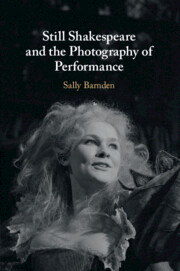Book contents
- Still Shakespeare and the Photography of Performance
- Still Shakespeare and the Photography of Performance
- Copyright page
- Dedication
- Contents
- Figures
- Acknowledgements
- Introduction: ‘Leave Not a Rack Behind’
- Part I Photographing Performers
- Part II Iconography, Photography, and Hamlet
- Chapter 4 ‘Too Much of Water’: Ophelia, Photography, Dissolution
- Chapter 5 ‘Poor Yorick’: The Photograph as Memento Mori
- Epilogue
- Bibliography
- Index
Chapter 5 - ‘Poor Yorick’: The Photograph as Memento Mori
from Part II - Iconography, Photography, and Hamlet
Published online by Cambridge University Press: 05 December 2019
- Still Shakespeare and the Photography of Performance
- Still Shakespeare and the Photography of Performance
- Copyright page
- Dedication
- Contents
- Figures
- Acknowledgements
- Introduction: ‘Leave Not a Rack Behind’
- Part I Photographing Performers
- Part II Iconography, Photography, and Hamlet
- Chapter 4 ‘Too Much of Water’: Ophelia, Photography, Dissolution
- Chapter 5 ‘Poor Yorick’: The Photograph as Memento Mori
- Epilogue
- Bibliography
- Index
Summary
This chapter examines the long history of depictions of Hamlet with Yorick’s skull, acknowledging that this composition has a longer history than that of the play itself. Considering versions of the ‘Yorick still’ in relation to medieval and early modern memento mori art, I argue firstly that photography was a significant determining factor in this image’s rise to prominence and ubiquity. Secondly, I suggest that the uncanny qualities of the photograph, as they are discussed for instance by Roland Barthes in Camera Lucida, allow photographs based on Hamlet to revive some of the spectral qualities of the memento mori. The chapter concludes with reflections on ‘playing dead’ in photographs of Hippolyte Bayard and Sarah Bernhardt.
Keywords
- Type
- Chapter
- Information
- Still Shakespeare and the Photography of Performance , pp. 192 - 224Publisher: Cambridge University PressPrint publication year: 2019

